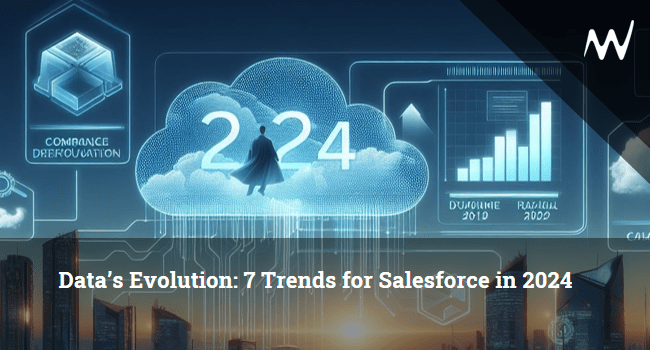Data’s Evolution: 7 Trends for Salesforce in 2024

Introduction:
2024 Data Trends: A Look at Salesforce’s Evolution
In the ever-evolving landscape of customer relationship management (CRM), data has emerged as the focal point for Salesforce professionals. As the lifeblood of CRMs, data quality is a constant concern. In this roundup, we delve into some noteworthy Salesforce-specific data trends that are shaping the way organizations leverage information. While not exhaustive, these trends provide insights into the future of data within the Salesforce ecosystem.
1. Consumer Data Collection (CDP):
Customer Data Platforms (CDPs) integrated with the Salesforce platform, such as Salesforce Genie, have become integral to the commercial cloud. With Genie extending the capabilities of Salesforce CDP, the focus remains on data integration, identity resolution, and activation. The zero-data per architecture distinguishes Genie from its predecessor, contributing to its flexibility and versatility.
2. Following the First Party:
In response to privacy concerns and the decline of third-party cookies, organizations are placing a renewed emphasis on collecting first-party data. CDPs play a vital role in managing the increasing complexity of data collection, requiring organizations to strike a balance between personalization and privacy.
3. Salesforce Workstations:
Salesforce Industries is gaining significant traction, offering industry-specific data models to organizations. Industry Cloud products, such as Healthcare Cloud and Financial Services Cloud, provide pre-built structures, enabling organizations to align their strategies without building custom Salesforce data models.
4. Advantages of Unstructured Data:
Unstructured data, often not conforming to specific standards, is predicted to gain prominence. Customer Data Platforms offer a way to bring standardization to unstructured data, unlocking its potential. Notably, integrating Slack chat data with Salesforce showcases the potential of organizing unstructured collaboration.
5. Salesforce Flow:
Recognized as the veins and arteries of CRM, Salesforce Flow plays a pivotal role in transforming and moving data within the system. Advanced features, including Data Elements, Collections, Loops, and Assignments, elevate the capabilities of Salesforce Flow. The native Flow data table component simplifies working with multiple records simultaneously, enhancing user experience.
6. Data Security:
As the importance of data grows, so does the need for robust security measures. Salesforce professionals are increasingly concerned about both malicious attacks and insider threats. Understanding the Salesforce Shared Responsibility Model is crucial, outlining the security measures for which Salesforce and customers share responsibility.
7. Data Security:
Security keeps some Admins and other Salesforce professionals up at night. The stakes are high, with both malicious attacks and insider threats on the rise for companies that use Salesforce.
Yes, insider threats – your own colleagues compromising your org data’s security, either deliberately or out of negligence. It’s critical to have the proper controls in place to prevent data loss.
Some people overlook this blind spot because they don’t fully understand the concept of the Salesforce Shared Responsibility Model. Data protection is a joint responsibility with Salesforce.
The guidelines below outline the security measures that Salesforce is responsible for as opposed to customer responsibility.
Conclusion:
In a landscape where data reigns supreme, staying ahead of trends is crucial for Salesforce professionals. Whether exploring new avenues in data collection, leveraging industry-specific models, or mastering advanced Flow features, Salesforce users must prioritize data security, backup, storage, and quality. As we navigate the intricate world of CRM, Salesforce’s evolving tools continue to make these priorities more manageable for organizations.
To learn more, talk to our experts today. Book your free consultation now!
You may also connect with us by mail at info@wrinom.com.
